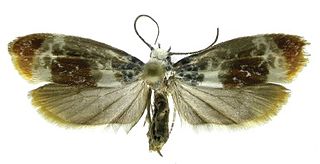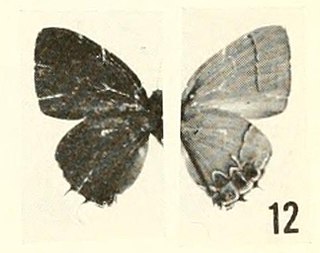Related Research Articles

Rhizedra lutosa, the large wainscot or Isle of Wight wainscot, is a species of moth of the family Noctuidae. It is native to the Palearctic realm. It has been introduced into eastern North America and is spreading.

Adaina bipunctatus is a moth of the family Pterophoridae. It is found in the United States, including Florida and Mississippi. It has also been recorded from Trinidad, the West Indies, Brazil and Ecuador.
Athis palatinus is a moth in the Castniidae family. It is found from Mexico south to Peru and Brazil.

Cahela is a monotypic snout moth genus described by Carl Heinrich in 1939. Its only species, Cahela ponderosella, the cahela moth, described by William Barnes and James Halliday McDunnough in 1918, is found in Mexico and in the US states of California, Texas, Arizona, Utah and probably Nevada.

Ethmia mnesicosma is a moth in the family Depressariidae. It is found from Mexico to northern Venezuela and Trinidad. There is also a record from southern Brazil.
Epeiromulona biloba is a moth of the subfamily Arctiinae. It was described by William D. Field in 1952. It is found in Panama and Colombia.
Epeiromulona icterinus is a moth of the subfamily Arctiinae. It was described by William D. Field in 1952. It is found in Guatemala and Panama.
Epeiromulona lephina is a moth of the subfamily Arctiinae. It was described by William D. Field in 1952. It is found in Panama and Guatemala.
Epeiromulona roseata is a moth of the subfamily Arctiinae, described by William D. Field in 1952. It is found in Mexico, Honduras, and Costa Rica.

Epeiromulona thysanata is a moth of the subfamily Arctiinae. It was described by William D. Field in 1952. It is found in French Guiana, Guyana, Suriname, Costa Rica and Panama.
Rupela tinctella is a moth in the family Crambidae. It was described by Francis Walker in 1863. It is found in Florida, Georgia, Louisiana, Mississippi, North Carolina, South Carolina, Texas, Mexico, Cuba, the Guianas, Trinidad, Brazil (Paraná), Paraguay and northern Argentina.
Diaphania arguta is a moth in the family Crambidae. It was described by Julius Lederer in 1863. It is found in Florida, Mexico, Guatemala, Costa Rica, Panama, Colombia, Venezuela, Trinidad, Tobago, Guyana, French Guiana, Suriname, Brazil, Peru and Bolivia.
Diaphania elegans is a moth in the family Crambidae. It was described by Heinrich Benno Möschler in 1890. It is found in Puerto Rico, Hispaniola, Jamaica, Cuba, Costa Rica, Panama, Guatemala, Honduras, Mexico and southern Texas. It is also found in South America, where it has been recorded from Venezuela, Trinidad, Ecuador, Peru, Brazil, Paraguay and Argentina.
Acraga goes is a moth of the family Dalceridae. It is found in Costa Rica, Ecuador, Venezuela, Trinidad, Guyana, Surinam, French Guiana, Colombia, Peru and Brazil. The habitat consists of tropical wet, tropical moist, tropical dry, tropical premontane wet, tropical premontane moist and subtropical dry forests.
Acraga hamata is a moth of the family Dalceridae. It is found in Costa Rica, Panama and possibly Colombia. The habitat consists of tropical premontane wet and rain forests at altitudes above 800 meters.
Acraga beebei is a moth of the family Dalceridae. It is found in northern Venezuela. The habitat consists of tropical premontane moist forests.
Acraga citrina is a moth of the family Dalceridae. It is found in Trinidad, Venezuela, Guyana, Surinam, French Guiana and northern Brazil. The habitat consists of tropical moist, tropical dry, tropical premontane moist and tropical premontane dry forests.
Acraga angulifera is a moth in the family Dalceridae. It was described by Schaus in 1905. It is found in Trinidad, Venezuela, Surinam and French Guiana. The habitat consists of tropical moist forests.
Minacraga disconitens is a moth in the family Dalceridae. It was described by Schaus in 1905. It is found in Venezuela, Trinidad, Guyana, Surinam, French Guiana, Brazil, eastern Peru and Bolivia. The habitat consists of tropical moist, tropical premontane wet, tropical premontane moist, subtropical moist and warm temperate moist or dry forests.

Calycopis pisis, the pisis groundstreak, is a butterfly found in several countries in Latin America.
References
- ↑ Field, William D. (1952). "Moths of the Genus Epeiromulona, a New Genus of Lepidoptera" (PDF). Proceedings of the United States National Museum. 102 (3308): 455–469. doi:10.5479/si.00963801.102-3308.455.
- Pitkin, Brian & Jenkins, Paul. "Search results Family: Arctiidae". Butterflies and Moths of the World. Natural History Museum, London.